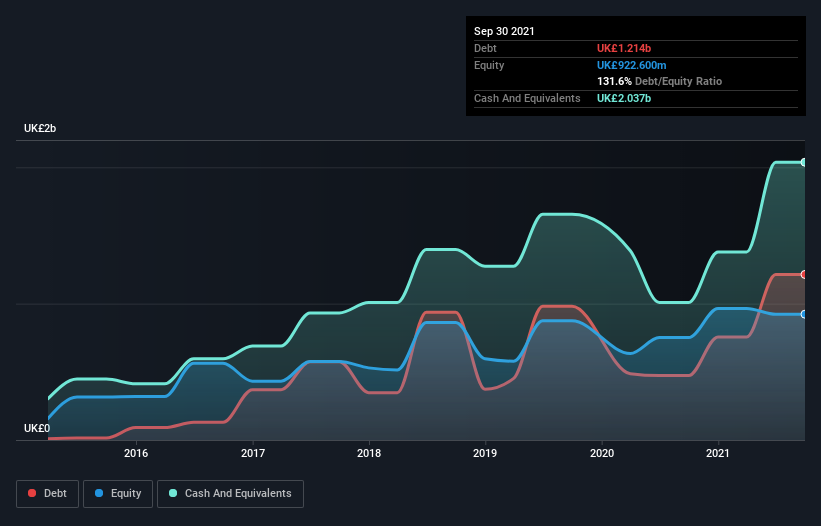Health Check: How Prudently Does Jet2 (LON:JET2) Use Debt?
David Iben put it well when he said, 'Volatility is not a risk we care about. What we care about is avoiding the permanent loss of capital.' When we think about how risky a company is, we always like to look at its use of debt, since debt overload can lead to ruin. As with many other companies Jet2 plc (LON:JET2) makes use of debt. But is this debt a concern to shareholders?
When Is Debt Dangerous?
Debt and other liabilities become risky for a business when it cannot easily fulfill those obligations, either with free cash flow or by raising capital at an attractive price. Part and parcel of capitalism is the process of 'creative destruction' where failed businesses are mercilessly liquidated by their bankers. However, a more common (but still painful) scenario is that it has to raise new equity capital at a low price, thus permanently diluting shareholders. Of course, debt can be an important tool in businesses, particularly capital heavy businesses. The first thing to do when considering how much debt a business uses is to look at its cash and debt together.
View our latest analysis for Jet2
What Is Jet2's Net Debt?
You can click the graphic below for the historical numbers, but it shows that as of September 2021 Jet2 had UK£1.21b of debt, an increase on UK£472.1m, over one year. However, it does have UK£2.04b in cash offsetting this, leading to net cash of UK£823.0m.
A Look At Jet2's Liabilities
According to the last reported balance sheet, Jet2 had liabilities of UK£1.26b due within 12 months, and liabilities of UK£1.40b due beyond 12 months. Offsetting these obligations, it had cash of UK£2.04b as well as receivables valued at UK£124.2m due within 12 months. So its liabilities total UK£490.8m more than the combination of its cash and short-term receivables.
Since publicly traded Jet2 shares are worth a total of UK£3.05b, it seems unlikely that this level of liabilities would be a major threat. However, we do think it is worth keeping an eye on its balance sheet strength, as it may change over time. While it does have liabilities worth noting, Jet2 also has more cash than debt, so we're pretty confident it can manage its debt safely. There's no doubt that we learn most about debt from the balance sheet. But ultimately the future profitability of the business will decide if Jet2 can strengthen its balance sheet over time. So if you want to see what the professionals think, you might find this free report on analyst profit forecasts to be interesting.
In the last year Jet2 had a loss before interest and tax, and actually shrunk its revenue by 61%, to UK£525m. That makes us nervous, to say the least.
So How Risky Is Jet2?
By their very nature companies that are losing money are more risky than those with a long history of profitability. And the fact is that over the last twelve months Jet2 lost money at the earnings before interest and tax (EBIT) line. Indeed, in that time it burnt through UK£95m of cash and made a loss of UK£366m. With only UK£823.0m on the balance sheet, it would appear that its going to need to raise capital again soon. Overall, we'd say the stock is a bit risky, and we're usually very cautious until we see positive free cash flow. The balance sheet is clearly the area to focus on when you are analysing debt. However, not all investment risk resides within the balance sheet - far from it. For example, we've discovered 3 warning signs for Jet2 that you should be aware of before investing here.
Of course, if you're the type of investor who prefers buying stocks without the burden of debt, then don't hesitate to discover our exclusive list of net cash growth stocks, today.
Have feedback on this article? Concerned about the content? Get in touch with us directly. Alternatively, email editorial-team (at) simplywallst.com.
This article by Simply Wall St is general in nature. We provide commentary based on historical data and analyst forecasts only using an unbiased methodology and our articles are not intended to be financial advice. It does not constitute a recommendation to buy or sell any stock, and does not take account of your objectives, or your financial situation. We aim to bring you long-term focused analysis driven by fundamental data. Note that our analysis may not factor in the latest price-sensitive company announcements or qualitative material. Simply Wall St has no position in any stocks mentioned.

 Yahoo Finance
Yahoo Finance 
